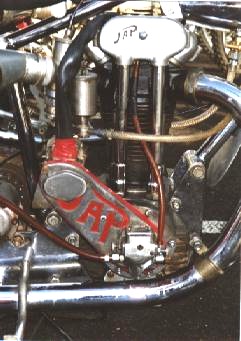


For over four decades, the J.A.P Speedway engine (named after the John. A. Prestwich & Co Manufacturers) was to dominate the Speedway scene. The following pages looks at the history of this incredible engine.
New additions to this series of Pages are the Technical Specifications page for the more technical minded amongst you and the Workshop where pictures of JAP variations can be found.
IF JOHN Prestwich had not had second thoughts after his first visit to a local speedway meeting, it is quite probable the speedway engine may never have come into being. Stan Greening had encouraged him to pay a visit to Stamford Bridge one evening, yet surprisingly he had come away quite unimpressed. To him, speedway racing was little more than another new craze that would soon pass, just like the earlier roller skating fad. He gave it six months at the most and then, to use his own words, `the bubble will burst'.
Fortunately, Stan Greening had more faith in speedway's long-term prospects for he had already been able to observe, first-hand in his spare time role of Machine Examiner at the track, how the sport was progressing. It will come as no surprise that he retained a keen interest in racing right up to his retirement, by which time he had completed almost 50 years with J. A. Prestwich and Co. Ltd, and had risen to the position of Chief Technical Advisor, so it was only be to expected that he would become interested in speedway racing when it first came to Britain during I928. In no time at all. he found himself closely associated with the Stamford Bridge track.

The factory's involvement with speedway racing became the subject for further discussion during the 1929 Motor Cycle Show at Olympia. Bill Bragg who was then Captain of the Stamford Bridge team, happened to call at the S JAP stand when Vivian Prestwich was on duty. They got into conversation and it was fortunate that it was Vivian he had singled out, for his words did not fall on deaf ears. Having taken a keen personal interest in Bert Le Vack's earlier development work, and indeed helped him on numerous occasions, Vivian was shrewd enough to realise that perhaps speedway had more to offer than his S father had suspected. Through this further representation, John Prestwich changed his mind and gave the project his blessing. Given the go-ahead. Stan Greening started work along the lines Bill Bragg had indicated and in a matter of something like three months an experimental engine was delivered to Bill's home, for him to install in a frame and try.
It would be pleasant to report that the engine proved an instant success during its first trials, but sadly this was not so. At the particular time the 4-valve Rudge engine was just taking over from the previously all-conquering Douglas twin, to become the machine on which to achieve the most wins. Unfortunately, the experimental JAP engine was still too heavy and it was also well down on power when matched against the 28 bhp of the Rudge.